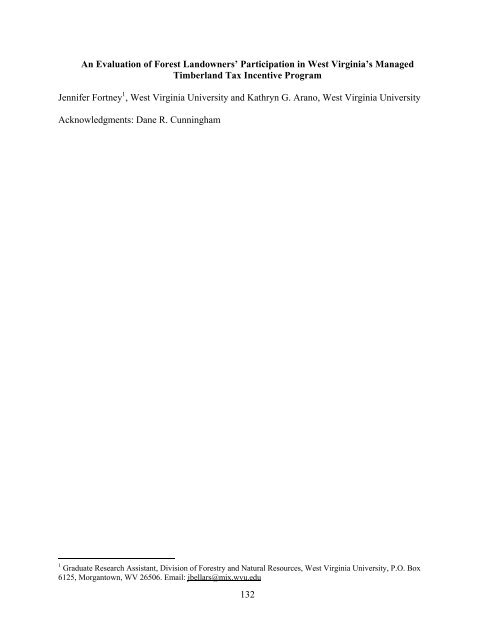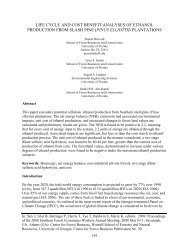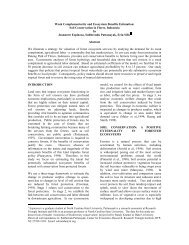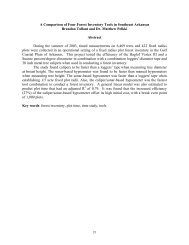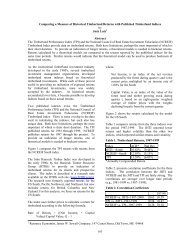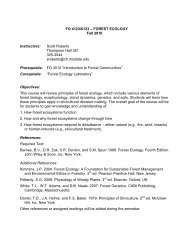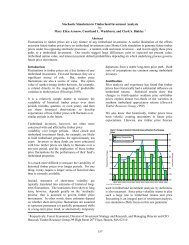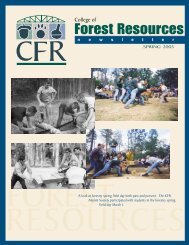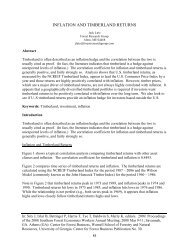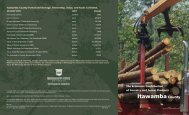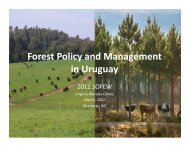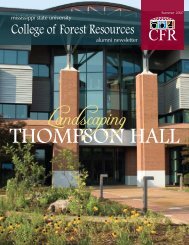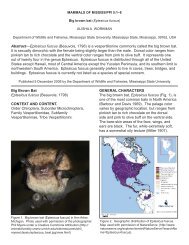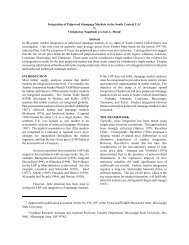Participation in West Virginia's Managed Timberland Tax ... - sofew
Participation in West Virginia's Managed Timberland Tax ... - sofew
Participation in West Virginia's Managed Timberland Tax ... - sofew
Create successful ePaper yourself
Turn your PDF publications into a flip-book with our unique Google optimized e-Paper software.
An Evaluation of Forest Landowners’ <strong>Participation</strong> <strong>in</strong> <strong>West</strong> Virg<strong>in</strong>ia’s <strong>Managed</strong><br />
<strong>Timberland</strong> <strong>Tax</strong> Incentive Program<br />
Jennifer Fortney 1 , <strong>West</strong> Virg<strong>in</strong>ia University and Kathryn G. Arano, <strong>West</strong> Virg<strong>in</strong>ia University<br />
Acknowledgments: Dane R. Cunn<strong>in</strong>gham<br />
1 Graduate Research Assistant, Division of Forestry and Natural Resources, <strong>West</strong> Virg<strong>in</strong>ia University, P.O. Box<br />
6125, Morgantown, WV 26506. Email: jbellars@mix.wvu.edu<br />
132
An Evaluation of Forest Landowners’ <strong>Participation</strong> <strong>in</strong> <strong>West</strong> Virg<strong>in</strong>ia’s <strong>Managed</strong><br />
<strong>Timberland</strong> <strong>Tax</strong> Incentive Program<br />
Abstract<br />
Preferential property tax treatment of forested land is part of legislative policy <strong>in</strong> all 50<br />
states. <strong>West</strong> Virg<strong>in</strong>ia’s forest land tax, <strong>Managed</strong> <strong>Timberland</strong>, is designed to promote retention of<br />
private forest land <strong>in</strong> forested use. Many <strong>in</strong>dividual states have been the subject of studies on<br />
both structure and effectiveness of their preferential forest tax programs. However, <strong>West</strong><br />
Virg<strong>in</strong>ia’s <strong>Managed</strong> <strong>Timberland</strong> Program, <strong>in</strong> effect s<strong>in</strong>ce 1991, has not been scrut<strong>in</strong>ized at the<br />
level of other states’ programs. In <strong>West</strong> Virg<strong>in</strong>ia, private forest land owners hold 9.7 million<br />
acres of forest land, but <strong>Managed</strong> <strong>Timberland</strong> enrolled acres have rema<strong>in</strong>ed at approximately 2<br />
million acres s<strong>in</strong>ce 1998. This lack of enrollment may be a cause for concern regard<strong>in</strong>g the<br />
success and benefits of the program. This study analyzes participant and non-participant<br />
characteristics to identify factors that <strong>in</strong>fluence the choice to participate <strong>in</strong> the <strong>Managed</strong><br />
<strong>Timberland</strong> Program and propose strategies for improv<strong>in</strong>g the program. Results suggest that low<br />
enrollment may be attributable to lack of knowledge, poor adm<strong>in</strong>istration, and failure to target<br />
landowner beliefs. Landowners currently enrolled are satisfied with the program.<br />
Keywords: preferential forest taxes, property tax, private forest landowners, land use policy,<br />
green space preservation.<br />
133
Introduction<br />
In <strong>West</strong> Virg<strong>in</strong>ia, the preferential property tax policy for forested land is called the<br />
<strong>Managed</strong> <strong>Timberland</strong> Program. Individual states have been the subject of several studies on both<br />
structure and effectiveness of their forest property tax programs (e.g., Baughman et al. 2003;<br />
Jacobson 2001; Rathke 1993; Wagner et al. 2002). However, the <strong>West</strong> Virg<strong>in</strong>ia’s tax <strong>in</strong>centive<br />
program has not been scrut<strong>in</strong>ized at the level of other states’ forest tax <strong>in</strong>centive programs. <strong>West</strong><br />
Virg<strong>in</strong>ia Division of Forestry (DOF) Director Dye (2006), <strong>in</strong> the required annual report to the<br />
legislature (Cook 2007), notes a lack of new or <strong>in</strong>creased enrollment s<strong>in</strong>ce 1998, which was<br />
preceded by a drop <strong>in</strong> enrollment start<strong>in</strong>g <strong>in</strong> 1995, only four years after the <strong>Managed</strong> <strong>Timberland</strong><br />
Program’s <strong>in</strong>ception. The lack of enrollment <strong>in</strong> <strong>West</strong> Virg<strong>in</strong>ia’s <strong>Managed</strong> <strong>Timberland</strong> program<br />
s<strong>in</strong>ce 1998 may be a cause for concern regard<strong>in</strong>g the success of the policy. It has long been<br />
noted that forestry is suited to <strong>West</strong> Virg<strong>in</strong>ia both environmentally and economically, for timber<br />
and recreational tourism (Eke 1929; Peck 1929). The <strong>West</strong> Virg<strong>in</strong>ia legislature declared forest<br />
preservation to be <strong>in</strong> the public <strong>in</strong>terest when pass<strong>in</strong>g <strong>Managed</strong> <strong>Timberland</strong> <strong>in</strong>to law (WV Code<br />
§11–1C–11). Therefore it is important to understand forest landowner attitudes toward <strong>Managed</strong><br />
<strong>Timberland</strong> <strong>in</strong> <strong>West</strong> Virg<strong>in</strong>ia. This study analyzes participant and non-participant characteristics<br />
to identify factors that <strong>in</strong>fluence the choice to participate <strong>in</strong> the <strong>Managed</strong> <strong>Timberland</strong> Program<br />
and propose strategies for improv<strong>in</strong>g the program.<br />
Methodology<br />
The data for this study were collected from a mail survey that was conducted from<br />
August 2008 to February 2009. The study population consisted of non<strong>in</strong>dustrial private forest<br />
(NIPF) landowners <strong>in</strong> <strong>West</strong> Virg<strong>in</strong>ia who own at least 10 acres of forest land. <strong>Managed</strong><br />
<strong>Timberland</strong> has a ten acre m<strong>in</strong>imum acreage requirement and the study population is limited to<br />
landowners who are enrolled or who are eligible to enroll but do not. A random sample of<br />
landowners was drawn from two landowner databases. The first sample came from a list,<br />
provided by the <strong>West</strong> Virg<strong>in</strong>ia Division of Forestry, of landowners who are enrolled <strong>in</strong> the<br />
program. Industrial forest landowners and corporations were rejected from the sample. The<br />
second sample <strong>in</strong>cluded landowners who have not participated <strong>in</strong> the program, as drawn from a<br />
landowner database obta<strong>in</strong>ed from the State <strong>Tax</strong> Assessor’s Office. Bus<strong>in</strong>esses, landowners with<br />
less than ten acres, and landowners whose names appeared on the <strong>Managed</strong> <strong>Timberland</strong> list were<br />
rejected from the sample. A target of 400 usable responses <strong>in</strong> each group was set to achieve a 5%<br />
sampl<strong>in</strong>g error at a 95% confidence level. A 30% response rate was assumed, requir<strong>in</strong>g a total of<br />
1,300 landowners from each group to be <strong>in</strong>cluded <strong>in</strong> the sample.<br />
Dillman’s (2000) Tailored Design Method was used <strong>in</strong> develop<strong>in</strong>g and adm<strong>in</strong>ister<strong>in</strong>g the<br />
mail survey. Where available, surveys from previous forest landowner studies were consulted so<br />
that responses could be compared to other results (e.g. Birch and K<strong>in</strong>gsley 1978; Rathke 1993;<br />
Jacobson 2001; and Joshi 2007). Three mail<strong>in</strong>gs were sent to the potential survey respondents to<br />
ensure a high response rate: <strong>in</strong>itial mail<strong>in</strong>gs of the survey <strong>in</strong>strument (August 2008), a follow-up<br />
mail<strong>in</strong>g of a rem<strong>in</strong>der letter (November 2008), and f<strong>in</strong>al mail<strong>in</strong>g with a cover letter and another<br />
copy of the survey <strong>in</strong>strument to non-respondents (January 2009). The f<strong>in</strong>al total response rate<br />
was 42%.<br />
134
The survey <strong>in</strong>struments collected <strong>in</strong>formation on three categories: 1.) property<br />
<strong>in</strong>formation (e.g., forest acreage, length of ownership, distance of residence); 2.) forest property<br />
tax-related questions (e.g. amount of property taxes, knowledge of the <strong>Managed</strong> <strong>Timberland</strong><br />
Program, attitudes toward property taxation, reasons for participat<strong>in</strong>g or not participat<strong>in</strong>g <strong>in</strong> the<br />
managed <strong>Timberland</strong> Program); and 3.) landowner demographics (e.g., age, <strong>in</strong>come).<br />
Summary statistics were calculated for the variables collected from the survey.<br />
Comparison of means for the cont<strong>in</strong>uous variables was conducted us<strong>in</strong>g SAS. Frequencies and<br />
χ^2 statistics for the distribution differences between the two groups were calculated us<strong>in</strong>g<br />
LIMDEP.<br />
Results<br />
The survey <strong>in</strong>struments were mailed to a total of 2,600 potential respondents, 1,300 to<br />
each group, participants <strong>in</strong> <strong>Managed</strong> <strong>Timberland</strong> and non-participants. A total of 1, 394 surveys<br />
were returned, of which 939 were usable responses, for a total response rate of 42%. The<br />
response rates <strong>in</strong> the subsamples were 61% for participants and 19% for non-participants. The<br />
response rate for the non-participants was low so there was a concern about non-response bias.<br />
To test for non-response bias the mean number of acres from the 76 non-participant refusals was<br />
compared to the mean number of acres from the 188 usable non-participant surveys. No<br />
statistical difference was found.<br />
While a majority (33 to 40%, depend<strong>in</strong>g on the activity) of participants <strong>in</strong>dicated that<br />
elim<strong>in</strong>ation of the program would not change their management decisions, 22% said that they<br />
would be much more likely to sell all of their land if the program were elim<strong>in</strong>ated. Accord<strong>in</strong>g to<br />
Dye (2006), there are approximately two million acres <strong>in</strong> the <strong>Managed</strong> <strong>Timberland</strong> Program, so<br />
while 22% is not the majority, there still exists a potential impact on an estimated 440,000 acres<br />
of forested land <strong>in</strong> <strong>West</strong> Virg<strong>in</strong>ia if the program were to be elim<strong>in</strong>ated.<br />
Participants <strong>in</strong> <strong>Managed</strong> <strong>Timberland</strong> were asked to rate their satisfaction with their<br />
<strong>Managed</strong> <strong>Timberland</strong> assessment and their perceived percent sav<strong>in</strong>gs as a result of the program.<br />
The majority of participants (41%) said they were satisfied with their assessment, but 37% said<br />
they did not know if they were satisfied and 33.5% <strong>in</strong>dicated that they did not know their level of<br />
tax sav<strong>in</strong>gs. This <strong>in</strong>dicates that NIPF landowners do not understand the method of valuation for<br />
<strong>Managed</strong> <strong>Timberland</strong> acres, which likely affects their overall level of satisfaction with the<br />
program and their likelihood to <strong>in</strong>form others about the program.<br />
Most participants also said that they were satisfied with the adm<strong>in</strong>istration of the program<br />
with 89% satisfied with the tax assessor and 93% satisfied with the DOF. Of those that were not<br />
satisfied, most reported dissatisfaction with the tax assessor because they did not understand how<br />
their forest land valuation was determ<strong>in</strong>ed and/or the tax assessor was hostile to the program.<br />
Reasons for dissatisfaction with the DOF were primarily the annual contract renewal requirement<br />
and not understand<strong>in</strong>g their property valuation, neither of which are <strong>in</strong> actuality determ<strong>in</strong>ed by<br />
the state DOF. These are further <strong>in</strong>dicators that NIPF landowners do not understand all aspects of<br />
the program, even if they are enrolled.<br />
135
Both participants and non-participants were asked to rate the level to which they<br />
supported or opposed some primary aspects of the program. Most non-participants did not feel<br />
qualified to answer the question. The strongest opposition among participants strongest was<br />
aga<strong>in</strong>st the annually renewed contract (19.82%) and tax assessor authority (17.75%). Strongest<br />
support was for the program’s lack of withdrawal penalties (49.32%) and lack of public access<br />
requirements (63.05%). Table 1 summarizes the percentages for each level of scal<strong>in</strong>g for each<br />
aspect of <strong>Managed</strong> <strong>Timberland</strong> for participants.<br />
Table 1: Support and opposition from participants to aspects of the <strong>Managed</strong> <strong>Timberland</strong><br />
Program.<br />
Strongly<br />
Oppose<br />
Oppose Neutral Support Strongly<br />
Support<br />
Don't<br />
Know<br />
Annually Renewed 19.82% 15.80% 26.97% 9.09% 18.78% 9.54%<br />
Contract<br />
Forest Management Plan 3.15% 5.71% 25.83% 18.77% 35.29% 11.26%<br />
DOF Approval 3.31% 5.11% 26.67% 21.80% 30.68% 11.43%<br />
<strong>Tax</strong> Assessor Authority 17.75% 13.96% 33.08% 6.53% 8.95% 19.73%<br />
Method of Valuation 5.71% 8.49% 37.35% 8.95% 10.19% 29.32%<br />
10 Acre M<strong>in</strong>imum 6.53% 4.41% 29.03% 16.41% 29.94% 13.68%<br />
No Withdrawal Penalty 3.61% 2.71% 19.55% 11.13% 49.32% 13.68%<br />
No Public Access Req. 4.22% 1.51% 11.76% 5.88% 63.05% 13.57%<br />
No Provision for lost<br />
Local Rev.<br />
3.38% 2.61% 30.41% 6.91% 32.10% 24.58%<br />
Both groups were also asked to choose from a list of suggested changes to <strong>Managed</strong><br />
<strong>Timberland</strong> and any other changes they would like to see implemented <strong>in</strong> the program. The most<br />
frequently selected changes among participants were <strong>in</strong>crease the reapplication time (51.08%),<br />
larger tax breaks (39.97%), or no change (26.59%). Many non-participants <strong>in</strong>dicated that they<br />
felt unqualified to answer the question (39.18%), but of those who did answer, the most common<br />
selected changes were larger tax break (30.93%), no change (18.56%), and provide state<br />
reimbursement to local government for lost funds due to the tax break (6.19%).<br />
The means for the two groups for distance resid<strong>in</strong>g from their forested property were<br />
85.68 miles for non-participants and 108.15 miles for participants. The mean difference test<br />
showed these to not be statistically different at the .05 level. The average number of years owned<br />
for participants was 18.46 and 24.27 years for non-participants. This difference was statistically<br />
significant. Program participants tended to own more parcels and more acres at 1.83 parcels and<br />
236.42 acres on average. These were also statistically different from non-participants who<br />
owned, on average, 1.62 parcels and 115.88 acres.<br />
When asked to cite multiple reasons for ownership, participants chose hunt<strong>in</strong>g (69.3%)<br />
and timber (62.2%) over any other categories, while non-participants cited pass<strong>in</strong>g on to heirs<br />
(56.68%) and hunt<strong>in</strong>g (54.01%) more than other categories. However, when asked to choose just<br />
one primary reason, participants cited leav<strong>in</strong>g to heirs (21.64%) and personal residence (18.26%)<br />
over other categories. Hunt<strong>in</strong>g dropped to 12.76%, but still rank<strong>in</strong>g fourth and timber dropped to<br />
18.09%, rank<strong>in</strong>g third as a primary ownership reason. Non-participants also chose the same<br />
136
easons, but <strong>in</strong> opposite order, with personal residence at 33.33% and leav<strong>in</strong>g to heirs at 27.89%.<br />
For non-participants, hunt<strong>in</strong>g dropped to 7.48% rank<strong>in</strong>g third as a primary ownership reason,<br />
while timber was fifth (7.48%) after land <strong>in</strong>vestment (8.16%). For both <strong>Managed</strong> <strong>Timberland</strong><br />
participat<strong>in</strong>g and non-participat<strong>in</strong>g landowners, pass<strong>in</strong>g to heirs and hav<strong>in</strong>g the land as the<br />
location of their personal full time residence are the most important primary reason for own<strong>in</strong>g<br />
forest land <strong>in</strong> <strong>West</strong> Virg<strong>in</strong>ia. Hunt<strong>in</strong>g and timber are important multiple use objectives for both<br />
groups as well.<br />
Most participants reported that they first heard about <strong>Managed</strong> <strong>Timberland</strong> from a<br />
professional forester (37.14%). Compare this to the non-participants’ responses for reasons they<br />
are not enrolled, of which 62.21% reported that they had never heard of the program. Figure 1<br />
summarizes the reasons non-participants reported for not enroll<strong>in</strong>g.<br />
Figure 1: Reasons reported for not enroll<strong>in</strong>g <strong>in</strong> <strong>Managed</strong> <strong>Timberland</strong> by <strong>West</strong> Virg<strong>in</strong>ia forest land owners.<br />
All demographic characteristics from the two groups were statistically different. Participants<br />
were likely to have higher <strong>in</strong>comes and higher levels of education. Participants were more likely<br />
to describe their occupations as professional, management, white collar, or skilled trade. While<br />
non-participants were also <strong>in</strong> these groups, they made up more of the respondents who reported<br />
themselves as blue collar, farmers, or work<strong>in</strong>g <strong>in</strong> the service <strong>in</strong>dustry. Participants were more<br />
frequent <strong>in</strong> younger age classes.<br />
The average property tax per acre between participants and non-participants was not<br />
statistically different at the .05 level, with participants pay<strong>in</strong>g $10.42 per acre, and nonparticipants<br />
pay<strong>in</strong>g $12.00 per acre, on average. However, unusually high <strong>Managed</strong> <strong>Timberland</strong><br />
taxes per acre were found to be from only the same four counties, Hampshire, Berkeley, Morgan,<br />
and Monongalia. Furthermore, these four counties are all located <strong>in</strong> the eastern panhandle region<br />
(except Monongalia) and are all under severe development pressure (American Farmland Trust<br />
2009). Removal of values over $25 per acre from the data resulted <strong>in</strong> observations from only<br />
those four counties be<strong>in</strong>g removed. The new mean with these values deleted was found to be<br />
137
$5.28 per acre, which is statistically different from the $12.00 per acre average property tax paid<br />
by non-participants.<br />
Discussion and Conclusions<br />
Most of those enrolled <strong>in</strong> <strong>Managed</strong> <strong>Timberland</strong> first heard about the program through a<br />
professional forester. The most commonly cited reason for not be<strong>in</strong>g enrolled was because the<br />
respondent had never heard of the program. Furthermore many of those not enrolled <strong>in</strong>dicated<br />
that they would either consider future enrollment (24.6%) or were unsure if they would consider<br />
future enrollment (62.6%). This <strong>in</strong>dicates the importance of advertis<strong>in</strong>g the program. If<br />
enrollment is to be the device by which program success is measured then <strong>West</strong> Virg<strong>in</strong>ia forest<br />
landowners need to know the program exists. Use of public friendly means, such as radio or<br />
television announcements, to communicate the presence of the program is recommended.<br />
At the time this study was <strong>in</strong>itiated, <strong>West</strong> Virg<strong>in</strong>ia reported a need for 44 state DOF<br />
foresters (WV Division of Personnel 2007). To improve enrollment, more foresters need to be <strong>in</strong><br />
contact with the public. Salary and benefits packages for <strong>West</strong> Virg<strong>in</strong>ia state foresters should be<br />
made more attractive to encourage professional foresters to seek employment <strong>in</strong> the state. In<br />
addition, creat<strong>in</strong>g more forester positions with<strong>in</strong> the state DOF will give foresters more time to<br />
conduct public outreach for <strong>Managed</strong> <strong>Timberland</strong>, as well as other forest management <strong>in</strong>centive<br />
programs.<br />
<strong>Managed</strong> <strong>Timberland</strong> participants tended to have more education and <strong>in</strong>come and to be<br />
employed with<strong>in</strong> professional jobs over non-participants. Previous research shows that<br />
landowners with higher exogenous <strong>in</strong>comes tend to forego harvest <strong>in</strong>come <strong>in</strong> favor of amenity<br />
value (Dennis 1989). A potential equity issue then arises <strong>in</strong> the preferential forest tax. Forest tax<br />
<strong>in</strong>centives may be subsidiz<strong>in</strong>g private non-timber amenity consumption rather than <strong>in</strong>creas<strong>in</strong>g<br />
timber supply. This may be especially troubl<strong>in</strong>g <strong>in</strong> terms of the stated policy objective of open<br />
space for social welfare when the absence of public access requirements <strong>in</strong> <strong>West</strong> Virg<strong>in</strong>ia’s<br />
<strong>Managed</strong> <strong>Timberland</strong> is also considered.<br />
The lack of statistical significance <strong>in</strong> the difference between the average taxes per acre of<br />
those enrolled to those who are not enrolled is also a potential <strong>in</strong>dicator of problems with the<br />
policy. Removal of values over $25 per acre from the data resulted <strong>in</strong> observations be<strong>in</strong>g<br />
removed from only four counties, Monongalia, Hampshire, Morgan, and Berkeley. Removal of<br />
these unusually high assessments resulted <strong>in</strong> a significant difference <strong>in</strong> taxes paid per acre<br />
between program participants and non-participants. Hampshire, Morgan, and Berkeley counties<br />
are listed by the American Farmland Trust as areas of prime farmland that is under threat of<br />
severe development pressure. Monongalia County is the location of Morgantown and <strong>West</strong><br />
Virg<strong>in</strong>ia University, and can also be considered a development pressure area. The implication of<br />
this result is that lands most <strong>in</strong> need of the policy effect of <strong>in</strong>creased tax sav<strong>in</strong>gs to reta<strong>in</strong><br />
ownership are not receiv<strong>in</strong>g the <strong>in</strong>tended benefit.<br />
Other areas of the state can also be considered to be under development pressure, for<br />
example many counties <strong>in</strong> the west along the Ohio River are listed by the American Farmland<br />
Trust as be<strong>in</strong>g prime farmland under development threat. However, none of these counties’<br />
138
observations were removed from the data for hav<strong>in</strong>g unusually high assessments. The high<br />
assessments only occurred <strong>in</strong> eastern panhandle counties, consistently. There is some evidence<br />
that this may be locally politically motivated. Several respondents reported <strong>in</strong> comments on the<br />
survey that their assessor was hostile to the <strong>Managed</strong> <strong>Timberland</strong> Program. Jefferson County,<br />
which neighbors Berkeley County, was the location of a recent development zon<strong>in</strong>g battle that<br />
went all the way to the <strong>West</strong> Virg<strong>in</strong>ia Supreme court twice. In the first case, Corliss et. al. v.<br />
Jefferson Co. Zon<strong>in</strong>g Board of Appeals, 2002, the Supreme Court ruled that local zon<strong>in</strong>g<br />
authorities had ultimate jurisdiction and had the right to decide on special permits and other<br />
ord<strong>in</strong>ances. This decision was <strong>in</strong> the favor of the developer. In Faraway Farms v. Jefferson Co.<br />
Board of Zon<strong>in</strong>g Appeals, 2008, the Supreme Court overturned its own precedent from Corliss<br />
and ordered the county zon<strong>in</strong>g authority to issue a special permit for subdivision and<br />
development to Faraway Farms.<br />
The legislative <strong>in</strong>tent of <strong>Managed</strong> <strong>Timberland</strong> is to provide a tax policy that encourages<br />
private owners to preserve forest land and enhance future forest quality (WV Code §11-1C-<br />
11(a)). So the objective of the policy is prevention of conversion of forested lands to more<br />
developed uses. An important question to address when analyz<strong>in</strong>g a policy is: Are the policy’s<br />
methods consistent with the policy’s <strong>in</strong>tent? Accord<strong>in</strong>g to Hibbard et al. (2003 and 2001), <strong>in</strong><br />
order for a policy to be capable of achiev<strong>in</strong>g its objective, the methods employed should be<br />
consistent with the stated goal. S<strong>in</strong>ce the policy goal is prevention of land conversion, perhaps<br />
current use systems based on timber market productivity pr<strong>in</strong>ciples are not the best system for<br />
assessment. Another potential problem with timber market criteria for assessment and<br />
compliance is that timber is not consistent with assessed landowner objectives. In <strong>West</strong> Virg<strong>in</strong>ia,<br />
landowners report bequest motives and a place to live to be their reasons for ownership. Timber<br />
is only important <strong>in</strong> a multiple use context, as reported by the survey respondents. The<br />
assessment of forest lands for <strong>Managed</strong> <strong>Timberland</strong> should therefore be based on a system that is<br />
consistent with the policy objective and salient landowner beliefs.<br />
This further leads to question<strong>in</strong>g of enrollment numbers as a measure of success. S<strong>in</strong>ce the<br />
goal of the policy is forest land preservation, a more appropriate measure would be number of<br />
acres preserved, or perhaps more importantly, the location of the acres preserved. Tabulat<strong>in</strong>g<br />
percent of total enrollment from the survey responses by county shows that Hampshire County,<br />
located <strong>in</strong> the eastern panhandle, ranks first. Of respondents enrolled <strong>in</strong> <strong>Managed</strong> <strong>Timberland</strong>,<br />
29% report that their forest parcels are located <strong>in</strong> Hampshire County. Morgan and M<strong>in</strong>eral<br />
Counties, also both located <strong>in</strong> the eastern panhandle rank 2 nd and 3 rd respectively. This means<br />
that most of the <strong>Managed</strong> <strong>Timberland</strong> parcels <strong>in</strong> the state are located <strong>in</strong> high development<br />
counties, so the policy has reached targeted areas. Compare this to Brockett and Gebhard’s<br />
(1999) Tennessee study <strong>in</strong> which they found that most Greenbelt participation occurs far away<br />
from development pressure areas. However there is still a problem with <strong>Managed</strong> <strong>Timberland</strong><br />
participants receiv<strong>in</strong>g unusually high assessments for a forest tax <strong>in</strong>centive program <strong>in</strong> these<br />
counties. Another issue that should not be overlooked is the possibility that land speculators<br />
could be us<strong>in</strong>g the program as a tax shelter <strong>in</strong> these counties. This concern was raised <strong>in</strong> the<br />
<strong>Managed</strong> <strong>Timberland</strong> report prepared by the DOF for the legislature (Dye 2006).<br />
Participants seem to be unclear about their assessments. On two separate questions on the<br />
survey more that 30% of program participant respondents <strong>in</strong>dicated uncerta<strong>in</strong>ty about tax sav<strong>in</strong>gs<br />
139
and satisfaction with assessment. Some comments from respondents echoed this concern with<br />
statements either declar<strong>in</strong>g the assessment method to be confus<strong>in</strong>g or ask<strong>in</strong>g for it to be<br />
expla<strong>in</strong>ed. Some respondents asserted that their taxes went up after enroll<strong>in</strong>g <strong>in</strong> <strong>Managed</strong><br />
<strong>Timberland</strong>. Others made statements that their local assessor was uncooperative, unresponsive,<br />
or seemed hostile to the program.<br />
The success of <strong>Managed</strong> <strong>Timberland</strong> h<strong>in</strong>ges on assessment be<strong>in</strong>g equitable, efficient,<br />
simple, stable, and visible (Hibbard et al. 2001). It is possible that the program could be<br />
improved by outreach and education to county tax assessors, as <strong>in</strong>dicated by participant<br />
comments and uncerta<strong>in</strong>ty about assessment. Respondent comments are anecdotal <strong>in</strong> nature, so<br />
future research on managed <strong>Timberland</strong> should <strong>in</strong>clude an assessment of county tax assessors’<br />
knowledge and attitudes about the program.<br />
Based on landowner responses to suggested changes to the program, <strong>in</strong>creas<strong>in</strong>g the<br />
amount of time between reapplication may improve enrollment. Nearly 20% of participants<br />
oppose renewal annually. Landowners <strong>in</strong>cluded comments that they found the annual renewal<br />
requirements onerous. Some compla<strong>in</strong>ed about hav<strong>in</strong>g to obta<strong>in</strong> a notary stamp from each county<br />
<strong>in</strong> which they owned land rather than one per year. A small percentage (3.49%) of those not<br />
enrolled <strong>in</strong>dicated that the certification process was too difficult and time consum<strong>in</strong>g as their<br />
reason for not be<strong>in</strong>g enrolled.<br />
In summary, possible reasons for low enrollment <strong>in</strong>clude lack of knowledge about the<br />
program, possible poor adm<strong>in</strong>istration of the program, and failure of the policy to target salient<br />
landowner beliefs <strong>in</strong> its methods. These short-com<strong>in</strong>gs of the program are consistent with results<br />
from other studies (e.g. Kilgore et al. 2007; Hibbard et al. 2003; Jacobson and McDill 2003;<br />
Young and Reichenbach 1987). Measures to improve enrollment <strong>in</strong> <strong>Managed</strong> <strong>Timberland</strong> should<br />
focus on solutions to these problems. Further study of <strong>Managed</strong> <strong>Timberland</strong> is needed. Research<br />
should assess the attitude of tax assessors. Welfare analysis is needed to determ<strong>in</strong>e if social<br />
benefits outweigh the costs of adm<strong>in</strong>ister<strong>in</strong>g the program. The lack of withdrawal penalties,<br />
concerns expressed by the DOF to the legislature (Dye 2006), and the high concentration of<br />
enrollment <strong>in</strong> rapidly develop<strong>in</strong>g counties <strong>in</strong>dicate that the degree to which the program is used<br />
as a tax shelter by developers needs <strong>in</strong>vestigation.<br />
In spite of problems with the program, overall landowners that are enrolled are pleased<br />
with the tax treatment. It would not be wise to elim<strong>in</strong>ate the <strong>Managed</strong> <strong>Timberland</strong> Program. A<br />
significant amount of landowners <strong>in</strong>dicate that elim<strong>in</strong>ation of the program would cause them to<br />
have to make socially undesirable (accord<strong>in</strong>g to policy <strong>in</strong>tent) land use choices. To make the<br />
policy more effective a larger tax break may be necessary. As with most policies of this nature,<br />
once enacted, there is seldom any go<strong>in</strong>g back.<br />
Literature Cited<br />
American Farmland Trust 2009. “Farm<strong>in</strong>g on the Edge.” Map available at:<br />
http://www.littlekanawha.com/map_westvirg<strong>in</strong>ia300.jpg<br />
140
Baughman, M. J., K. Updegraff, and J.C. Cervantes. 2001. “Motivat<strong>in</strong>g Forest Landowners <strong>in</strong><br />
the North Central United States.” Unpublished, University of M<strong>in</strong>nesota. Available at<br />
http:www.regional.org.au/au/<strong>in</strong>fro/2001/Baughman.htm.<br />
Birch, T.W. and N.P. K<strong>in</strong>gsley. 1978. The Forest Landowners of <strong>West</strong> Virg<strong>in</strong>ia. U.S.D.A. Forest<br />
Service, Resource Bullet<strong>in</strong> NE-58.<br />
Brockett, C. D., and L. Gebhard. 1999. “NIPF <strong>Tax</strong> Incentives: Do They Make a Difference?”<br />
Journal of Forestry. April: 16-21.<br />
Cook, G. 2007. Deputy Director of the <strong>West</strong> Virg<strong>in</strong>ia Division of Forestry. Telephone <strong>in</strong>terview.<br />
October 10.<br />
Dennis, D.F. 1989. “An Economic Analysis of Harvest Behavior: Integrat<strong>in</strong>g Forest Ownership<br />
Characteristics.” Forest Science 35: 1088-1104.<br />
Dillman, D.A. 2000. Mail and Internet Surveys- The Tailored Design Method. John Wiley and<br />
Sons, New York. 464p.<br />
Dye, C.R. 2006. Report on <strong>Managed</strong> <strong>Timberland</strong> Program. <strong>West</strong> Virg<strong>in</strong>ia Division of Forestry,<br />
December.<br />
Eke, P. A. 1929. “The Community as a Factor <strong>in</strong> Classify<strong>in</strong>g Land for Agricultural and Forestry<br />
Utilization <strong>in</strong> the <strong>West</strong> Virg<strong>in</strong>ia Appalachians.” Journal of Farm Economics, July (11), 412-<br />
421.<br />
Hibbard, C. M., M. A. Kilgore, and P. V. Ellefson. 2001. “Property <strong>Tax</strong> Programs Focused on<br />
Forest Resources: A Review and Analysis.” Staff Paper. University of M<strong>in</strong>nesota.<br />
Hibbard, C. M., M.A. Kilgore, and P.V. Ellefson. 2003. “Property <strong>Tax</strong>ation of Private Forests <strong>in</strong><br />
the United States.” Journal of Forestry, April/May: 44-49.<br />
Jacobson, M., and M. McDill. 2003. “A Historical Review of Forest Property <strong>Tax</strong>es <strong>in</strong><br />
Pennsylvania: Implications for Special Forestland <strong>Tax</strong> Programs.” Northern Journal of<br />
Applied Forestry 20: 53-60.<br />
Jacobson, M. 2001. “<strong>Tax</strong>es and Laws: Do They Change Landowner Behavior for the Better?”<br />
Unpublished, Pennsylvania State University. Available at<br />
http:www.regional.org.au/au/<strong>in</strong>fro/2001/jacobson.htm.<br />
Joshi, S. 2007. “Non<strong>in</strong>dustrial Private Landowner’s Characteristics and Their Forest<br />
Management Decisions.” M.S. Thesis, Division of Forestry and Natural Resources. <strong>West</strong><br />
Virg<strong>in</strong>ia University.<br />
Kilgore, M. A., J. M. Schertz, S. A., Snyder, and S. J. Taff. 2007. “Family Forest Owner<br />
Perceptions and Attitudes: M<strong>in</strong>nesota’s Susta<strong>in</strong>able Forest Incentives Act.” A report to the<br />
Bland<strong>in</strong> Foundation, University of M<strong>in</strong>nesota.<br />
Peck, M. 1929. “Farm or Forest <strong>in</strong> the <strong>West</strong> Virg<strong>in</strong>ia Appalachians?” Journal of Farm<br />
Economics, July (11), 422-435.<br />
Rathke, D. M. 1993. “An Evaluation of M<strong>in</strong>nesota’s <strong>Timberland</strong> Property <strong>Tax</strong> Laws.” M.S.<br />
Thesis, University of M<strong>in</strong>nesota.<br />
Wagner, J.E., C.J. Davis, D.E. Roczen, and L.P. Herr<strong>in</strong>gton. 2002. “Comb<strong>in</strong><strong>in</strong>g Zon<strong>in</strong>g<br />
Regulations and Property <strong>Tax</strong> relief to Reta<strong>in</strong><br />
Forestland and Promote Forest Management.” Northern Journal of Applied Forestry 19:<br />
59 -67.<br />
WV State Division of Personnel 2007. State Employment Website. Available at:<br />
http://www.state.wv.us/adm<strong>in</strong>/personnel/default.htm. Accessed October 30, 2007<br />
W.V. State Legislature. <strong>West</strong> Virg<strong>in</strong>ia Code § 11. “<strong>Tax</strong>ation.”<br />
141
Young, R. A., and M. R. Reichenbach. 1987. “Factors Influenc<strong>in</strong>g the Timber Harvest<br />
Intentions of Non<strong>in</strong>dustrial Private Forest Owners.” Forest Science. 33:2: 381-393.<br />
142


